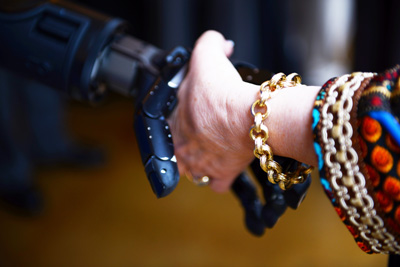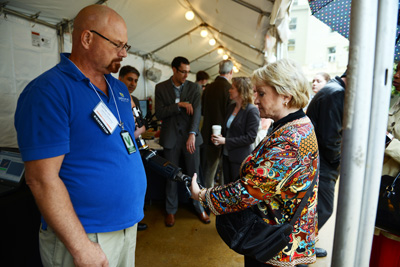By C. Todd Lopez
WASHINGTON (May 11, 2016) -- "This is the most advanced arm in the world. This one can do anything your natural arm can do, with the exception of the Vulcan V," said Johnny Matheny, using his right hand to mimic the hand greeting made famous by Star Trek's Leonard Nimoy. "But unless I meet a Vulcan, I won't need it."
Matheny was at the Pentagon, May 11, 2016, as part of "DARPA Demo Day," to show military personnel the robotic arm he sometimes wears as part of research funded by the Defense Advanced Research Projects Agency. DARPA is an agency of the U.S. Department of Defense responsible for the development of emerging technologies for use by the military.

Matheny lost his real left arm to cancer, and he said had doctors not cut it off -- above the elbow -- the cancer would have spread to the rest of his body. "I'd have been dead in three months," he said.
Before you are dazzled by the "mind-controlled" aspect of the Matheny's robotic arm, one of the most striking things you notice is that the arm is not attached to his body with the regular fiberglass cup and straps that are common to most prosthetic arms.
Instead, there is piece of metal sticking out of the end of his bicep onto which the robotic arm can be attached. The metal device has been surgically implanted into his arm, into the bone -- a true man/machine interface. That technique is called "osseointegration," and he's likely the first in the U.S. to have that done.
But what's really amazing about the robotic arm he wears is that he doesn't have to use his right hand to tell it what to do. Instead, he uses the muscles and nerves in what remains of his left arm to send signals to the robotic arm and hand. And then the arm and hand respond, just like a real arm.
"This is part of the Revolutionizing Prosthetics Program, where we set out to restore near-natural upper extremity control to our military service members who have lost limbs in service of our country," said Dr. Justin C. Sanchez, director of the Biological Technologies Office at DARPA. "The goal is to control the arm as naturally as possible. Before DARPA got into all of this, there weren't a whole lot of options for people living with that kind of condition. So we asked if we could develop an arm with the same size, weight, shape and grip strength compared to an adult human arm."
Sanchez said Matheny has had some procedures done to re-map some of the nerves in his arm so he is able to control them in a different way, to make use of the robotic arm.
"But it is a more natural way to control this arm, compared to switches or levers," Sanchez said.
Matheny bragged on the arm's capabilities.
"So far this thing works great," he said. "It's the arm of the future. This arm here, it can do 45 pounds. I can take on any one of these big old burley Soldiers around here. We'll get a 45 pound weight and keep going. I can keep going till the battery wears down. And when I feel it starting to go down, I say swap me out. They take it out, pop another battery in, and I keep going. I never miss a beat."

The real advances in the research being done by DARPA, Sanchez said, goes beyond the myoelectric control that Matheny is now using to control his robotic arm. Instead, Sanchez said, they want to provide real, direct control by the brain over the arm, over other prosthetics, or over any device.
"We are thinking deeply about how direct neural interfaces interact with complex military systems," Sanchez said. "An aircraft is one of them."
They had a video on display at their booth in the Pentagon courtyard, where a completely paralyzed subject is controlling an aircraft that is part of a video game, using only her mind.
"If you really want to get to natural control, you have to do this -- where we have human subjects have direct neural interfaces in their brain," he said. "They can think about moving their robotic arm and the signals come directly out of their brain, process in the arm, and can actually move the arm."
That kind of control requires neural implants into the subjects. And Sanchez said that the signals between the brain implants and the potential prosthetics don't have to just flow in one direction. They can put sensors in the prosthetic that feed signals back to the brain, so users can "feel" again.
"We have not only movement, but also sensation," he said. "For our most recent subject participating in this, we put sensors in their fingertips. And as you press on the fingertips, it sends signals back to the brain and he can feel you are pressing on his fingertips."
Michael P. McLoughlin, the chief engineer at the Research and Exploratory Development Department at Johns Hopkins Applied Physics Laboratory, said the benefits of the research they are doing for DARPA are aimed at making life normal again for Soldiers and other service members who come back from conflict with missing limbs -- to provide normalcy for them again.
"A lot of service members today that have come back from the current conflicts, they are teenagers, or in their 20s," he said. "They have young family members, young kids. This is about getting them back to life. That's what they want. They want to be able to go back and be able to do all the things we all did. This is about bringing them back to a capability they had before their injury."
Matheny's robotic arm is completely exposed black composite material and metal. You can see how it connects to his body, and you can see how it's put together. One wonders if it will be covered one day with a material that makes it appear to be a real arm. But McLoughlin said that hasn't been a priority for the team developing the technology that makes it work.
"The thing they are most interested in is that it moves naturally," he said of those who might benefit from it one day. "A lot of them like that look. They think it's cool they have a robotic arm. It's not so much a cosmetic thing, as it is functionality."